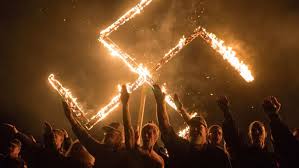Neo-Nazis are emerging as one of Australia’s most challenging security threats, according to the country’s top intelligence chief.
ASIO director general Mike Burgess says “small cells” of right-wing extremists are regularly gathering to salute Nazi flags, inspect weapons and to disperse their “hateful ideology”.
In a rare public address from inside ASIO’s heavily fortified Canberra headquarters, Mr Burgess said foreign espionage and interference activities against Australia were higher now than at any time during the Cold War.
While delivering ASIO’s annual threat assessment, the director-general warned a terrorist attack on Australia was still “probable” and it was “truly disturbing” to see extremists trying to recruit children as young as 13 or 14.
“The number of terrorism leads we are investigating right now has doubled since this time last year,” Mr Burgess told an audience of diplomats and intelligence officers.
“The character of terrorism will continue to evolve and we believe that it will take on a more dispersed and diversified face”.
Mr Burgess said right-wing extremism had been in “ASIO’s sights for some time”, but had obviously come into “sharp, terrible focus” following last year’s Christchurch mass shooting.
“In Australia, the extreme right-wing threat is real and it is growing,” he said.
“In suburbs around Australia, small cells regularly meet to salute Nazi flags, inspect weapons, train in combat and share their hateful ideology,” he said.
Far right-wing groups are now more organised and security conscious than they were in previous years according to the ASIO boss, who has revealed Australian extremists are seeking to connect with like-minded individuals in other parts of the world.
In a previously undisclosed case from earlier this year, ASIO advice led to an Australian being blocked from leaving the country to “fight with an extreme right-wing group on a foreign battlefield”.
“While these are small in number at this time in comparison to what we saw with foreign fighters heading to the Middle East, any development like this is very concerning,” Mr Burgess observed.
“Meanwhile, extreme right-wing online forums such as The Base proliferate on the internet, and attract international memberships, including from Australians.”
The ASIO boss said his organisation expected such groups would “remain an enduring threat, making more use of online propaganda to spread their messages of hate”.
“While we would expect any right-wing-extremist-inspired attack in Australia to be low capability — i.e. a knife, gun or vehicle attack — more sophisticated attacks are possible.”
Foreign espionage and interference at new heights
During his wide-ranging address, Mr Burgess declared the level of threat faced in Australia from foreign espionage and interference activities was “currently unprecedented”.
“It is higher now than it was at the height of the Cold War,” he said.
“Indeed, some of the tactics being used against us are so sophisticated, they sound like they’ve sprung from the pages of a Cold War thriller.”
For the first time, the intelligence chief disclosed the case of an unspecified foreign intelligence service that had sent a sleeper agent to Australia.
“The agent lay dormant for many years, quietly building community and business links, all the while secretly maintaining contact with his offshore handlers,” Mr Burgess revealed.
“The agent started feeding his spymasters information about Australia-based expatriate dissidents, which directly led to harassment of the dissidents in Australia and their relatives overseas.”
According to Mr Burgess, the agent received “significant cash payments” in exchange for providing “on-the-ground logistical support for spies who travelled to Australia to conduct intelligence activities”.
“These are the sort of insidious activities ASIO works to detect and disrupt every day,” Mr Burgess said, while confirming ASIO had disrupted the operation.

